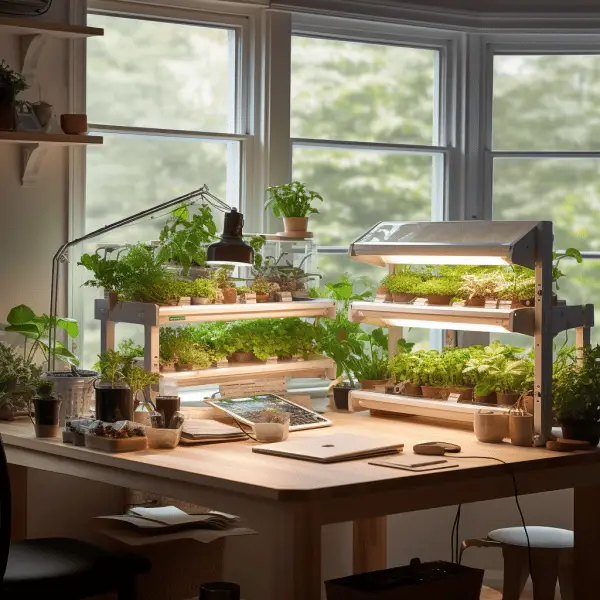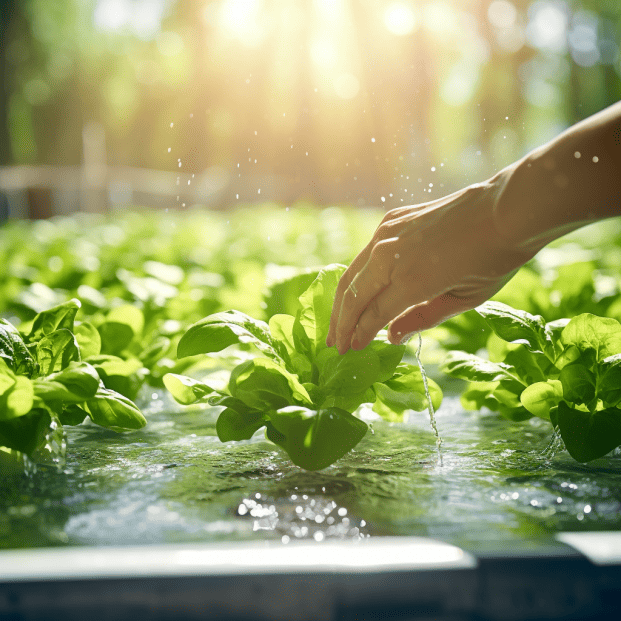When it comes to growing plants without soil using hydroponics, the type of water is crucial.
Yes, you can use tap water but there are a few things you must know first in order to succeed.
Let me tell you, I once thought any ol’ H2O would do the trick.
Boy was I wrong! I tried using water from my neighbor’s pond.
You should have seen the frogs I found floating around my tomatoes! Then there was the time I left a bucket of water out in the sun.
By the time I remembered it, the algae had grown so thick it looked like pea soup!
Through many experiences like these, I’ve learned a thing or two about what type of water plants really need.
In this guide I’ll walk you through the different options for hydro water, what to watch out for with each one, and how to modify your water source to maximize those bountiful harvests.
But I gotta warn you, if you don’t do it right, you may end up with a taste of your own medicine.
Do you remember old Farmer McGee and the year he piped in water straight from the cattle trough? Let’s just say his veggies had a more “organic” flavor than he bargained for!
To reap nature’s rewards, you need to give your plants just the right nourishment.
Keep reading to discover the watering methods I’ve perfected and how to set yourself up for a booming hydroponic operation.
But ignore my advice and you may find yourself cursing like a cow on St. Paddy’s Day!
KEY TAKEAWAY
What type of water to use for hydroponics?
Distilled water (1) is often the preferred choice for hydroponics due to its purity, as it lacks minerals and contaminants found in other water sources.
Other suitable water options for hydroponics include filtered water, rainwater, and reverse osmosis water, depending on their quality and availability in your region.
Understanding Water Sources for Hydroponics
Wondering what type of water works best for hydroponic systems? Water choice hugely impacts plant growth and health.
Let’s explore options.
All plants need water, but good hydroponic gardening starts with the right H2O.
Public tap water can work, yet often holds contaminants, varying pH and mineral levels.
These affect nutrient solution intake, risking imbalance, burns or worse.
Soil masks variations, but hydroponics puts water center stage.
We must control factors directly.
How does one choose? It starts with understanding sources and modifying as needed.
Focusing first on water sources primes all else.
If you need to know whether hydroponic plants need running water or not, check out the article.
Whether from faucet, rainfall or other means, why not let plants drink the purest refreshment? That brings us to distilled water.
The Role of Distilled Water in Hydroponic Farming

Distilled water proves the hoary standard for hydro gardening.
Its purity maximizes grower control.
But how exactly does this method work and why does it rule for hydroponic plants (2)?
Some insight may answer questions.
Steam-purified, distilled water contains zero dissolved solids or minerals, lowering conductivity to nil.
This lets nutrients add in perfect precision.
No excess skews pH or concentration.
Plus its consistency across batches maintains stable conditions.
Systems keep trucking without sudden water supply changes disrupting plants.
Problems clear up, growth skyrockets.
While some prefer reverse osmosis water for logical similar reasons, simple distilled remains quite affordable.
From common superstores, no specialized equipment required either.
Convenience triumphs.
So does producing abundant harvests.
So whether tinkering for fun or feeding families, distilled keeps hydroponic endeavors chugging.
No mucking with variables beyond ones control.
Low-cost yet unbeatable for purity, distilled delivers best results.
Hydro methods bloom beautifully when partnered with such a champion water source.
Dream big, my friends – and watch your greens thrive!
Advantages of Distilled Water in Hydroponics

When choosing a water source for hydroponic gardening, many options exist.
But few prove as useful as distilled water.
Its advantages help hydroponic nutrients nourish plants perfectly.
Since distilled water contains no dissolved minerals or contents, its purity affords precise control.
Gardeners know exactly what goes into each hydroponic solution.
No guessing how raw tap water impacts pH or nutrient levels.
This lets readers tailor recipes to a T.
No muddy variables muck results.
Plants get just what promotes healthy growth every time.
Stunted batches become a thing of the past.
Plus, distilled’s consistency means readers can rely on it anywhere, not depending on what emerges from regional pipes.
This lifts limitations on garden placement, opening more sites.
Costwise, no specialized equipment like reverse osmosis filters required either.
Distilled remains very affordable at most stores.
So whether space or budget matters most, this water type respects both.
Small wonder it leads the hydroponic pack!
Benefits of Hydroponic Farming Over Soil-Based Agriculture
For those seeking an easier, more productive gardening method, switching from soil to a hydroponic system offers rewards.
This progressive approach raises yields while cutting inputs.
What makes it truly shine?
Compared to soil’s unpredictable nutrient contents and mineral ranges, hydroponics lets gardeners customize feeding precisely.
With complete control, uncertainties disappear.
Stunted growth flees before such power!
Water treatment also becomes simpler.
Rather than wrestling soil’s absorbing nature, hydroponic fluids circulate openly in solution.
Any impurities get filtered out painlessly.
Even disease finds hydro hard to penetrate.
While beneficial bacteria commingle in earth, bare roots contact only sterilized tanks in hydroponics.
Pests vanish as pathogens flounder without soilborne access.
Yields soar too, with hydro’s ability to use full growing space.
Not a square millimeter gets wasted, for readers maximize every inch.
Versus soil limiting roots’ freedom, here plants drink and feed without deprival.
So whether producing food commercially or just seeking bounty, hydroponics streamlines harvesting and simplifies upkeep.
An easier, sturdier method shines bright indeed!
Common Crops Thriving in Hydroponic Environments
Curious what plants perform best with hydroponics? Some crops simply take to its pure water and tailored nutrients.
Knowing which to start eases trying this novel method.
Herbs grow like greens in these pure conditions.
Basil, mint and more burst forth.
Leafy friends like spinach, swiss chard and kale also do well.
Peppers, tomatoes – both love the humidity and stability.
Microgreens become a literal breeze too.
Their speedier lifecycles suit fast hydroponic rotations.
Lettuce varieties and salad mixes prosper rapidly as well.
Even flowers find hydroponic life quite nice.
Petunias and pansies paint happy pictures.
Others worth trying include gerbera daisies, marigolds and impatiens.
With complete control, possibilities spread far.
As for fruits, change just means starting seeds in rockwool or peat pellets before transplant.
Then strawberries, melons and more bear sweet results once established.
Curiosity can lead to exciting new harvests indeed!
Nutrient Requirements for Successful Hydroponic Gardening
To grow vigorously, plants require certain elements acquired from soil in nature.
In hydroponics , these nutrients come directly from prepared solutions.
Understanding basic needs preps readers well.
As a rule of thumb, water holds just carbon and oxygen.
Nitrogen , phosphorus and potassium rank essential, promoting healthy stems, leaves and blooms respectively.
Side meals include calcium , magnesium plus sulfur along with micronutrients like boron , copper and zinc.
All combine in recipes mirroring nature’s balanced perfection.
A standard nutrient reservoir thus includes primary, secondary and micronutrients.
Checking levels weekly keeps plants well-fed, making amounts easy to adjust accurately as garden grows.
With hydroponics letting growers supply nutrients directly in their purest forms, lively success seems guaranteed.
Just be sure the water stays clean too – that’s the fun part!
Exploring Various Hydroponic System Types
Curious types of hydroponic systems exist beyond basic nutrient solution floods and drips.
Each works H2O and plant roots in unique ways.
The epic ebb and flow alternates submerging roots before draining to refill.
Turntable-style Nutrient Film Technique grows roots inches above constant water film.
Bubbling up from zero-gravity aeroponics, mists coat roots with aerosol style hydration.
Wall-mounted living walls can stack plants vertically for smaller areas.
Some tinker wick systems using cord or cloth wicks to supply delicate herbs and flowers constant moisture.
For tight spaces too, creative stacking meets needs.
Wonderful how hydroponics blossoms beyond the basics!
Choosing the Best Water Source for Hydroponic Gardens
Key to any hydroponic garden stands selecting the ideal water source.
Beyond just being clean and safe, the suited type enhances plant growth without extra work.
This expert discusses top picks.
When possible, nothing surpasses pure reverse osmosis water.
Virtually mineral-free, it keeps nutrient solution parameters steady batch to batch.
Perfection abounds for plants and peace of mind for gardeners.
Yet filters and such equipment add upfront cost.
So many instead turn to distilled water.
Superstore affordable and containing zeros too, it provides reliability, if missing some extras.
Tap water’s high mineral content risks problems, yet filters and environment dictate safety odds.
Basic treatment, like filters or UV disinfection, can make it fit, but check those numbers.
Ultimately choose what supports your desired hydroponics style easily and thriftily.
Superior plant growth relies on simplistic water enabling readers give focus where it counts – thriving green beauties!
Conclusion
There you have it – the lowdown on water sources for hydro according to this experienced grower.
I hope these tips help you create optimal growing conditions to maximize your harvest’s size and quality.
Just be sure not to lose sight of this first critical piece of the puzzle.
Now it’s time to get started practicing these methods yourself.
Give your plants the best water has to offer and you’ll be chomping on all the veggies your heart desires in no time.
Wishing you green thumbs and full bellies!
And when you’re wrapped in the bounty of your hydroponic labors, don’t forget to pay the knowledge forward.
Share what you’ve learned with other gardeners looking to take the plunge.
You could inspire the next great crop of home growers.
Until next time, happy farming!
References
- https://www.webmd.com/diet/distilled-water-overview
- https://www.nal.usda.gov/farms-and-agricultural-production-systems/hydroponics
Related Articles
- https://tophydroponicgarden.com/hydroponics-introduction/
- https://tophydroponicgarden.com/does-hydroponics-need-running-water/
- https://tophydroponicgarden.com/what-is-hydroponics-2/
Was this helpful?

Crystal Erickson is an agriculture enthusiast and writer with a passion for sustainable farming practices and community development. Growing up on a family farm in rural Iowa, Crystal developed a love for the land and a deep appreciation for the hard work and dedication required to make a farm successful.
After completing a degree in Agriculture and Environmental Science from Iowa State University, Crystal began her career as an agricultural journalist, covering stories and issues related to modern farming practices, crop management, and livestock production. She quickly established herself as a respected voice in the industry, known for her insightful reporting and thoughtful analysis.
Over the years, Crystal has written for a variety of publications, including Farm Journal, Successful Farming, and Modern Farmer, as well as contributing to several academic journals focused on sustainable agriculture and community development. Her work has been recognized with numerous awards, including the Iowa Farm Bureau’s Young Farmer Achievement Award and the National Association of Farm Broadcasting’s Farm Broadcaster of the Year.


